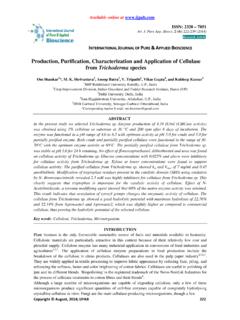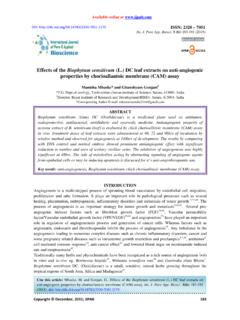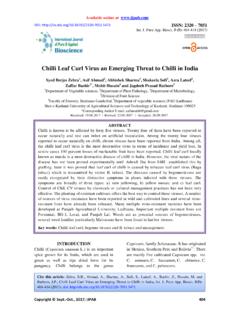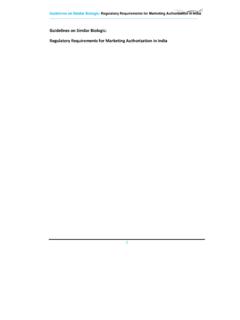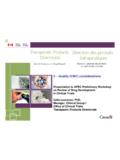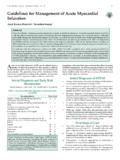Transcription of Nutritional Assessment and Health Status of Patients ...
1 Copyright June, 2015; IJPAB 45 Nutritional Assessment and Health Status of Patients Undergoing Dialysis Bahar ZULFIQUAR. Mukri1 and Rekha Battalwar2* 1Dr. College of home science, Women s University, Kidwai marg, Mumbai 2 Associate professor, Food and Nutrition Department, College of Home Science (Autonomous), Women s University, Juhu, Tara Road, Mumbai *Corresponding Author E-mail: INTRODUCTION Chronic diseases have become a major cause of global morbidity and mortality even in developing countries. The approximate prevalence of CKD is 800 per million populations (pmp), and the incidence of end-stage renal disease (ESRD) is 150-200 pmp1. Chronic kidney disease is a general term for heterogeneous disorders affecting kidney structure and function4. Kidney failure may occur from an acute situation that injures the kidneys or from chronic diseases that gradually cause the kidneys to stop functioning13.
2 Patients with chronic kidney disease (CKD) often experience a decline in their nutrient intake starting at early stages of CKD. This reduction in intake can affect both energy-producing nutrients, such as carbohydrates, proteins, and fats, as well as vitamins, minerals, and trace elements2. Available online at ISSN: 2320 7051 Int. J. Pure App. Biosci. 3 (3): 45-51 (2015) IINNTTEERRNNAATTIIOONNAALL JJOOUURRNNAALL OOFF PPUURREE && AAPPPPLLIIEEDD BBIIOOSSCCIIEENNCCEE Research Article ABSTRACT Objectives: The main aim of the study was to compare the Nutritional Status of subjects undergoing dialysis in a private hospital and government hospital. Methods: A cross sectional study was conducted in 100 subjects. A questionnaire was used to collect information regarding demographic profile, lifestyle pattern,medical history, biochemical parameters, food frequency questionnaire and 24 hours,3 days diet recall.
3 Anthropometric measurements were taken and BMI was questionnaire was used to assess the malnutrition of the analysis was performed using SPSS software. Paired T test and Chi square test was carried out. P-value < was considered to be statistically significant. Results: The average intake of energy, quality protein and calcium among private(government) hospital was 1694 kcal (1307kcal), ( ), 700mg (1062mg) respectively,this showed the intake of energy and quality protein was higher among private hospital subjects,whereas intake of calcium was higher in government hospital subjects. The anthropometric measurement was seen to be higher in private hospital SGPT and uric acid was seen to be normal in government hospitals whereas calcium and platelets were seen to be higher in private hospitals. The Subjective Global Assessment showed that the subjects from private hospital were well nourished by 48% whereas Government hospital subjects were severely malnourished by 36% and most of the subjects from both the hospitals were mild to moderately malnourished.
4 Conclusion: Statistical difference was seen in private and government hospital subjects with regards to Nutritional and Health need to be undertaken to improve food intake,nutrition knowledge and prevention of malnutrition of the population undergoing dialysis. Key words: Chronic Kidney Disease,Subjective Global Assessment ,Qualityprotein,Malnutrition, Dialysis. Copyright June, 2015; IJPAB 46 Mukri, and Battalwar, R. Int. J. Pure App. Biosci. 3 (3): 45-51 (2015) ISSN: 2320 7051 In view of the limited ability of dialysis Patients to cope with excess fluid and other metabolic wastes, it is vital that nutrient content of foods consumed by such Patients is given special considerations. Nutrient intakes of Patients receiving maintenance dialysis are often inadequate, and several lines of evidence suggest that toxins that accumulate with renal failure Suppress appetite and contribute to Nutritional decline3.
5 Malnutrition, a predictor of increased mortality in dialysis Patients , can be estimated using the subjective global Assessment (SGA), a semi quantitative scale with three severity levels7. The proper measures for assessing quality of life (QOL) in Patients with chronic kidney disease (CKD) remain unclear. Factors such as age, ethnic or national background, stage of CKD, modality of dialytic therapy, exercise interventions, sleep disturbances, pain, erectile dysfunction, patient satisfaction with care, depressive affect, symptom burden, and perception of intrusiveness of illness may be associated with differential perception of QOL. Recent studies showed an association between Assessment of QOL and morbidity and mortality in end-stage renal disease patients9. Current National Kidney Foundation Kidney Disease Outcomes Quality Initiative staging criteria for chronic kidney disease (CKD) are intended to apply to all age groups.
6 However, it is unclear whether different levels of estimated GFR (eGFR) have the same prognostic significance in older and younger patients15. MATERIALS AND METHODS A cross sectional study was conducted in 100 (50 subjects from Private and 50 from government hospital). A questionnaire was used to collect information regarding demographic profile, lifestyle pattern, medical history, and biochemical parameters of the study group. The medications was checked to assess the pre existing conditions of the subjects. The subjects were asked to maintain a diet record of 24 hours, 3 days (2 weekdays and 1 weekend).Energy, carbohydrates, protein, fats, and calcium, iron, phosphorous, sodium and potassium was calculated for the diet records. Food frequency questionnaire was used to understand the consumption of foods such as dairy products, meat and poultry, grain products, pulses and legumes, roots and tubers, other vegetables, fruits, fats and oils, and miscellaneous.
7 Anthropometric measurements such as height, weight, and pre dialysis and post dialysis weight were taken and Body Mass Index was calculated. Subjective Global Assessment questionnaire was used to assess the malnutrition of the subjects. Analysis was performed using SPSS software for Windows (version , 2007, SPSS Inc, Chicago, IL). Data are presented as Mean SD. Paired T test and Chi square test was carried out for all parameters. P-value < was considered to be statistically significant. RESULTS The results of the study includes the age, education qualification, anthropometric measurements, body mass index, biochemical parameters, medication and supplements, nutrient intake, subjective global Assessment and food frequency questionnaire of the subjects from both the private and government hospital. Both the subject groups were compared for the level of significance in relation to the above mentioned characteristics.
8 Demographic Profile : Number of subjects per range of age 0%50%100%150%20 -40 YEARS41 -60 YEARS61 -80 YEARSTOTALP rivateGovernmentCopyright June, 2015; IJPAB Mukri, and Battalwar, R. As shown in figure 1, out of 100 subjects, 50 subjects were from Private Hospital and 50 subjects were from government hospital. It was seen that subjects from both the hospitals were less in the age group of 20 to 40 years, government hospital subjects being higher in the age group of 41 to 60 years and private hospital subjects being higher in 61 to 80 years o20-40 years suffer from less of kidney related diseases in both private and government hospital. Fig. 2: Educational qualifications of the subjects In figure 2, the subjects from the private category whereas none of the subjects from the Government hospital were graduates. Majority of the subjects from the Govt. hospital were below SSC, followed by majority in between SSC and HSC.
9 Postgraduates were also higher in private hospital subjects (85%) as compared to government hospital subjects (25%). Table 1 Anthropometric Measurements of the subjectsHOSPITAL GENDER PRIVATE MALE FEMALE TOTAL GOVERNMENT MALE FEMALE TOTAL P value As shown in table1, there was a significant difference between the subjects from the two groups anthropometric measurements of the private subjects being higher than that of the government hospital subjects (p< ). There was significant difference among males and females in private and government hospital, both genders anthropometric measu 0%20%40%60%80%100%GovernmentPrivateNo. Of Subjectsin percentage5; IJPAB Int. J. Pure App. Biosci. 3 (3): 45-51 (2015) As shown in figure 1, out of 100 subjects, 50 subjects were from Private Hospital and 50 subjects were government hospital. It was seen that subjects from both the hospitals were less in the age group of 20 to 40 years, government hospital subjects being higher in the age group of 41 to 60 years and private hospital subjects being higher in 61 to 80 years of age.
10 This shows that subjects under the age group of 40 years suffer from less of kidney related diseases in both private and government qualifications of the subjects In figure 2, the subjects from the private hospital were seen to be Graduate with 16 subjects in that category whereas none of the subjects from the Government hospital were graduates. Majority of the subjects from the Govt. hospital were below SSC, followed by majority in between SSC and HSC. Postgraduates were also higher in private hospital subjects (85%) as compared to government hospital Table 1 Anthropometric Measurements of the subjects WEIGHT (Kg) HEIGHT (cm) PRE DIALYSIS WEIGHT (Kg) 158 As shown in table1, there was a significant difference between the subjects from the two groups anthropometric measurements of the private subjects being higher than that of the government hospital subjects (p< ).
